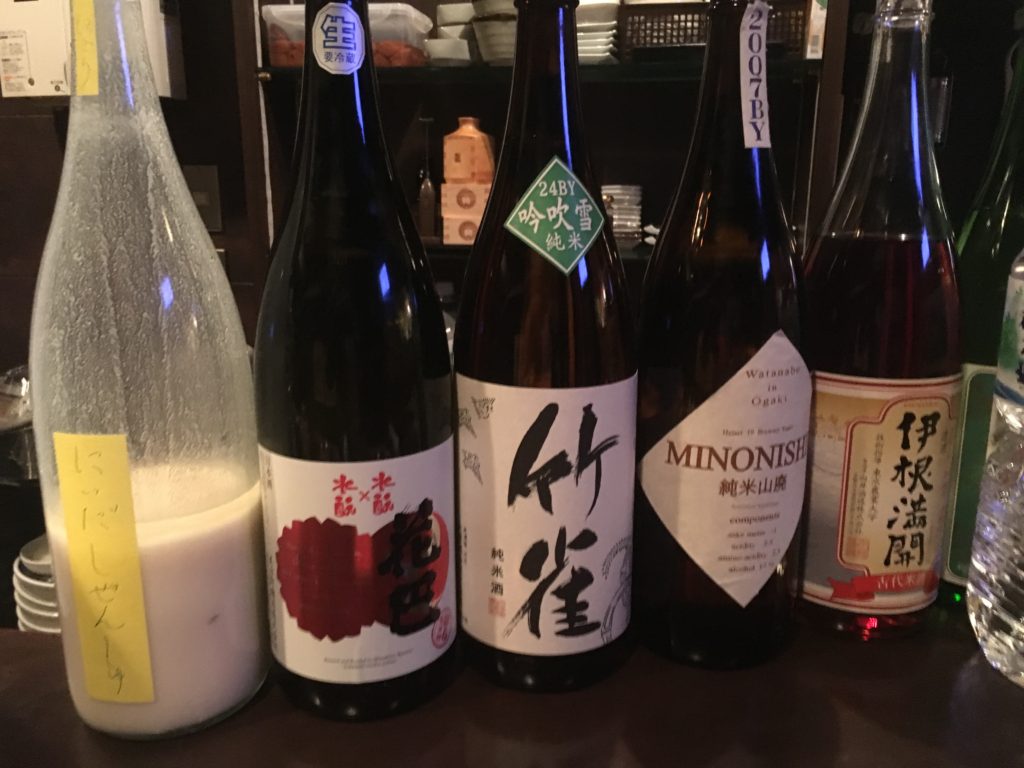
Written by Keita Okubo
Kan-zake (okan) means hot sake, a drinking style of warming up sake. There has been a custom of enjoying the flavor differences between different temperatures in Japan since ancient times, e.g. each restaurant had “okan-ban” or “osaka-ban,” a hot sake professional in the Edo period (the period between 1603 to 1868), similar to a modern sommelier/bartender.
Even now, there are professionals called “okan-ban” at restaurants and bars that specialize in sake, especially hot sake (some of them not only warm up sake but also serve it to customers).
I introduce such an “okan-ban,” of whom many sake aficionados have spoken of, saying, “He’s fantastic!” “He destroys my idea of hot sake!”

17-2, Maruyamacho, Shibuya, Tokyo 150-0044, Japan
1 min. from Shinsen Station (Keio Inokashira Line)
*Reservation Needed
Gats accepts only people
- Who can “sip” sake
- Who can speak Japanese or are with someone who can speak Japanese (in order to enjoy conversation with the owner Masa)
- Who want to learn “true sake”
What the hell are you doing?
He puts a milky material and another sake into nigori sake (unfiltered cloudy sake), warms it up and strains it…
This is Gats’ hot sake, and you’ll never see this at other places.
This is what he served to me.
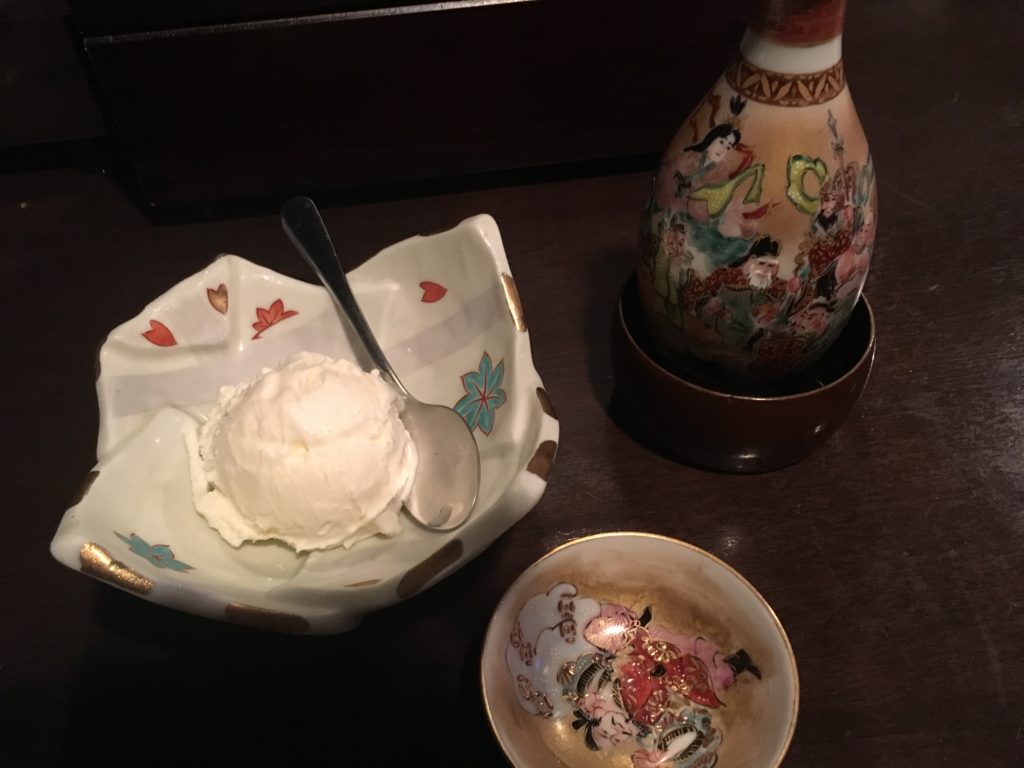
What he made is a hot cloudy liquid with a sweet coconut-like aroma.
As you taste it with vanilla ice cream, it turns into cheesecake in your mouth.
Can you believe it? It’s true even if you can’t. Although I know it’s sake, it tastes like delicious cheesecake.
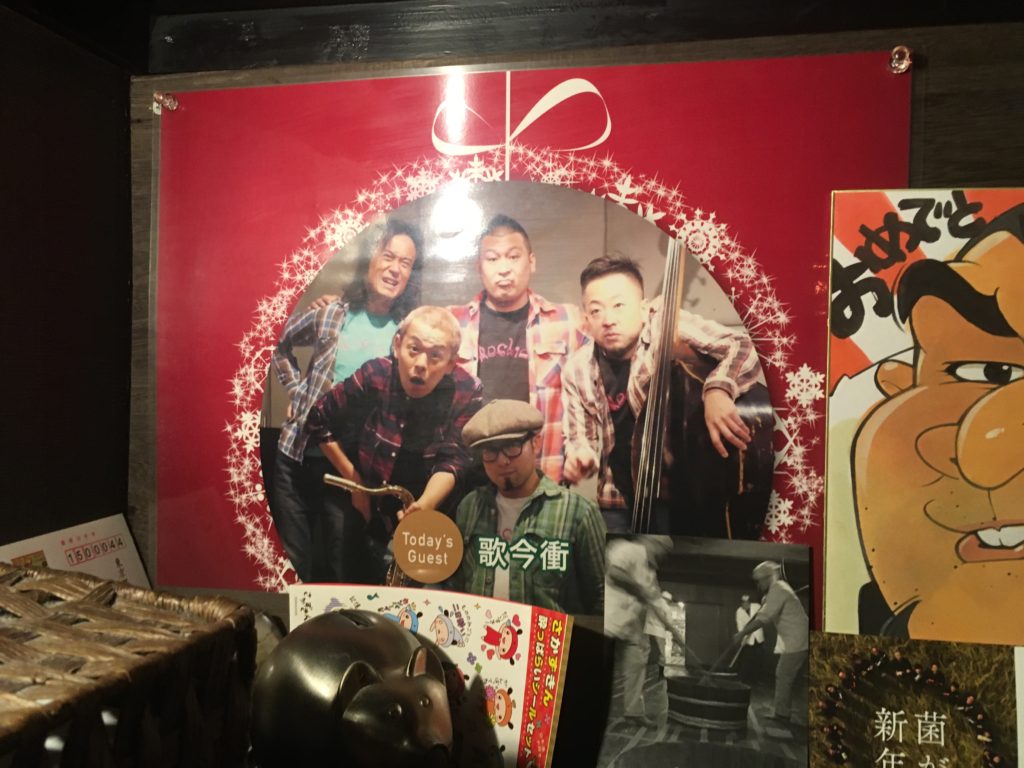
This picture shows the members of the jazz band that the owner Masa (upper middle) belongs to. I show his face with this picture because he was wearing a mask this day.
Masa is the most heretical guy among okan-ban in Japan. He warms up sake according to his own method. Niida-Honke, a popular sake brewery in Fukushima, evaluates his special technique and certifies him as its official okan-ban.
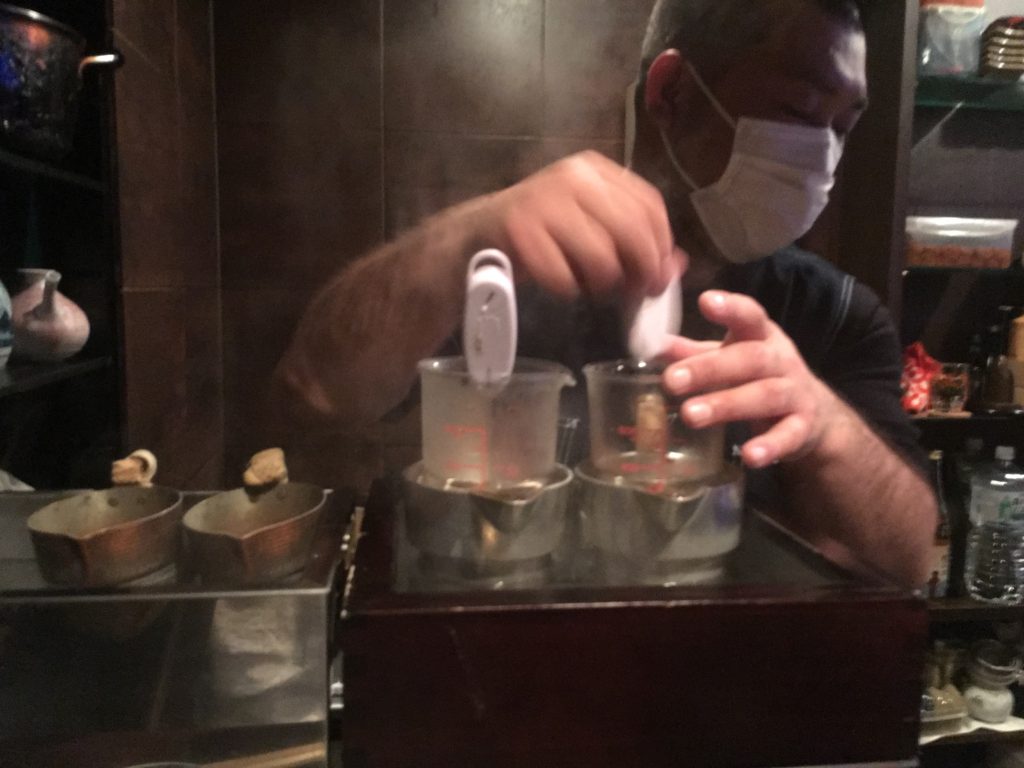
“Only tasty sake is worth being made into hot sake. This is because I drink only hot sake,” Masa said. He gave me such powerful comments one after another.
“Sake is an ingredient for cooking. If you rush to warm it up, you’ll burn it. On the other hand, it can be undercooked if you don’t warm it up enough. How you cook it depends on each sake.”
Honestly, I have no idea what he means.
The proof of the sake is in the drinking. He starts cooking the sake Niida Shizen-shu Junmai Ginjo by Niida-Honke.
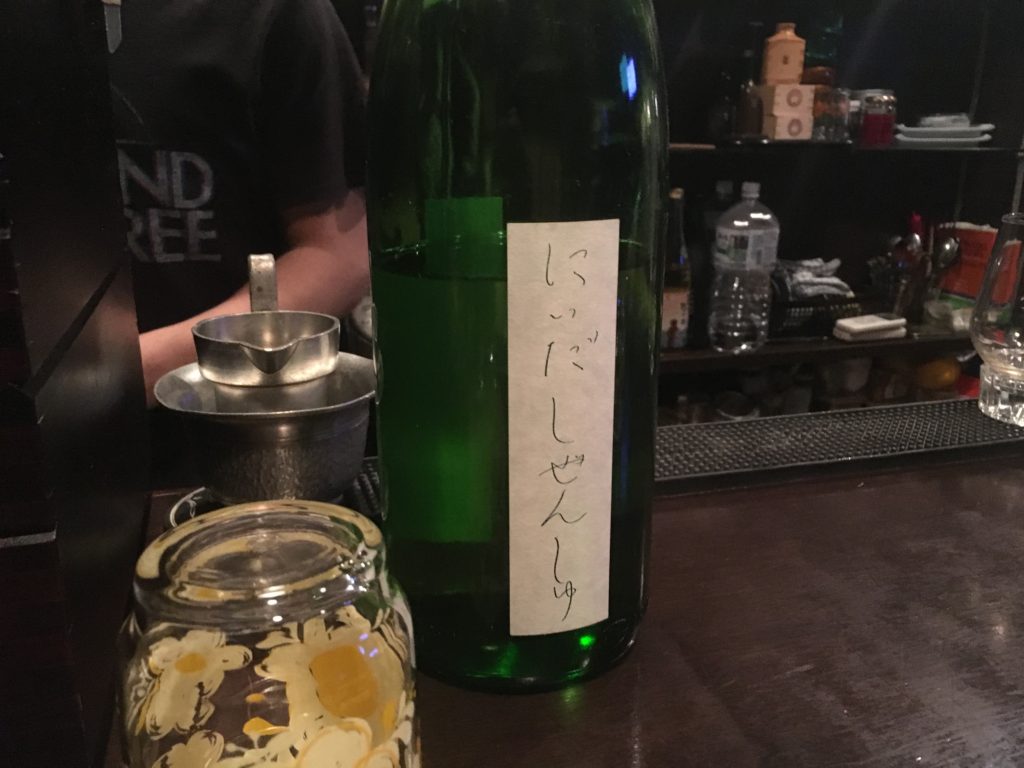
Surprisingly, he uses a beaker as a vessel to warm up the sake!
“I use three vessels for hot sake: a copper one, a tin one, and this beaker. Because this sake is delicate, it’s appropriate to warm it up with a beaker without any metallic influence.”
During the warming up of sake, Masa stands by a kan-doko (an automated utensil for heating sake) and stares at a thermometer. He keeps stirring sake while muttering, “Junmai Ginjo needs too much attention… it’s a handful.”
After warming it up for a while, Masa takes out the beaker, letting it rest a bit to lower the temperature, and then starts heating it up again.
“Please regard it as a nimono (Japanese traditional simmered food). Lowering the temperature makes its flavor richer.”
I sipped what Masa serves – oh, so delicious! As if there’s no barrier between the sake and my mouth. It soaks into my tongue smoothly.
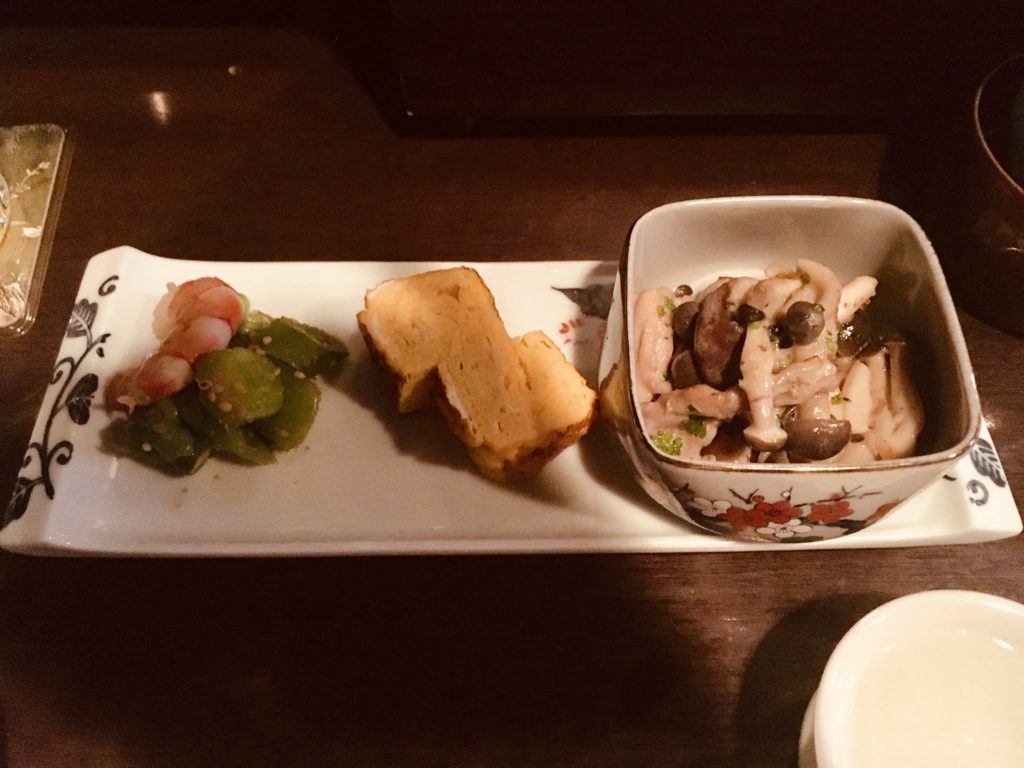
“Please drink this sake while ‘chewing’ a bite of food,” Masa said.
I took one bite. Amazing, this sake increases the flavor of food! It doesn’t just mean this sake is suitable for these nibbles, but that the combination amplifies the flavor – it’s a mystery.
“I mean, sake is freshly-cooked rice,” Masa said.
This sake tastes exactly like cooked rice. It goes well with anything I try: shrimps, Japanese omelet, mushrooms.
I totally understand that it’s very important to write specifically and clearly, as I worked as a writer and editor over the years. However, I can’t do that for my experience at Gats. I can understand it’s tasty, but I can’t understand what’s going on here. My mouth says, “yummy” before my brain starts functioning.
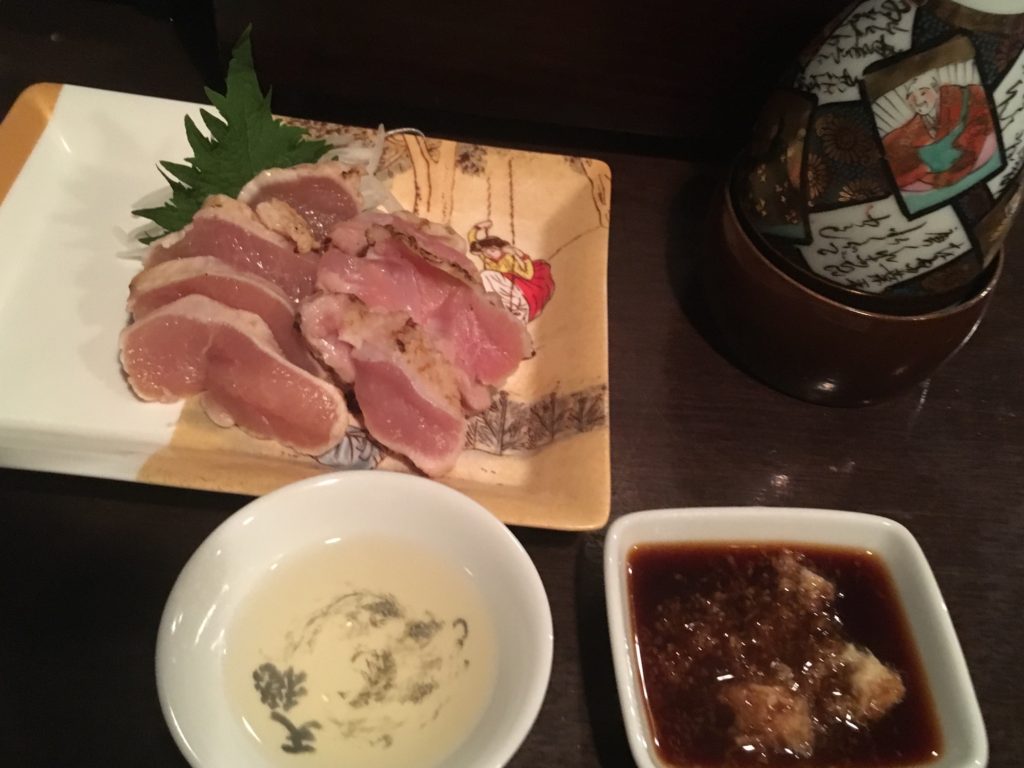
The next sake is Take-Suzume by Otsuka Brewery (Gifu). Masa pairs this with tori-sashi (chicken sashimi).
“Mix the grated ginger in soy sauce. Lick it a bit and taste the sake,” Masa said. Damn good. The sharpness of ginger and the mildness of soy sauce are harmonized by the rice flavor of sake. Paired with tori-sashi, the sake soaks between the fibers, which improves the flavor.
“This is a combination like the delicious tori-sashi and ginger takikomi-gohan (Japanese mixed rice),” Masa said.
It went over my head, but I surely feel that it tastes like freshly-cooked ginger rice – the best ginger rice I have ever tasted.
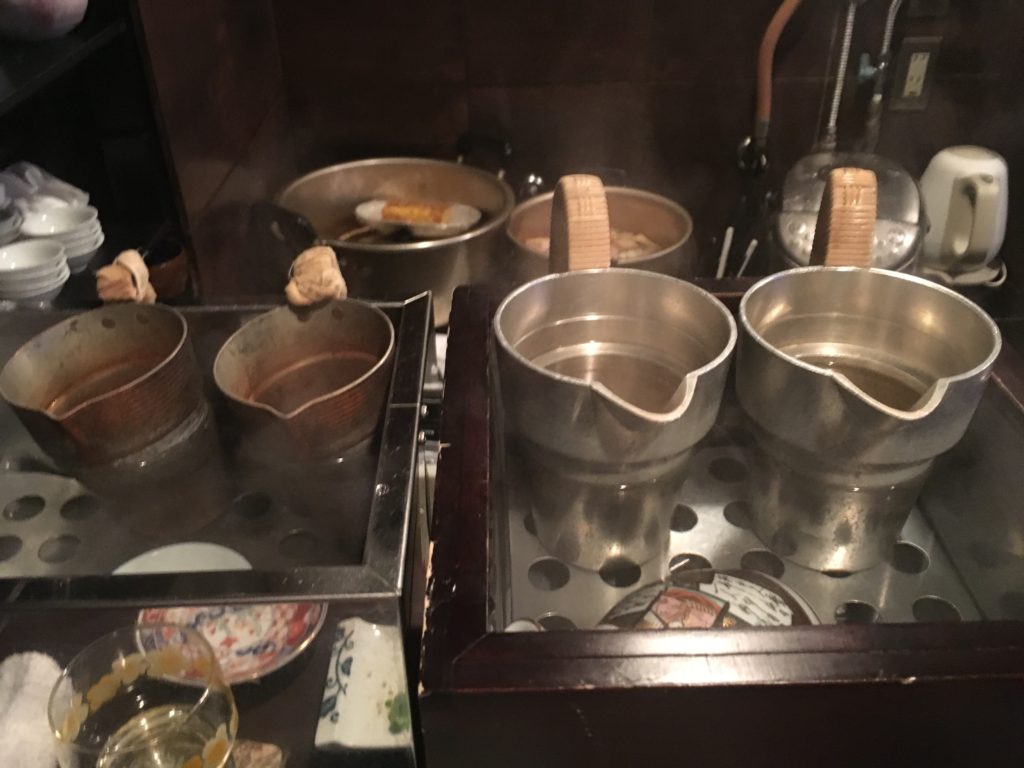
By the way, you can’t have nuru-kan (warm sake around 104℉) here; you can only drink atsu-kan (hot sake around 122℉) with tokkuri (a carafe for serving sake), which is too hot to hold (the name of kan-zake changes depending on its temperature by the way.)
“Have you ever felt such a tasty sake?” Masa said. “It’s the same as uncooked rice! Why do you make lukewarm stuff from the beginning? Rice can be tasty even it gets cold because it had been fully cooked before. Nuru-kan is a drinking style to enjoy the flavor change of the sake as it drops its temperature in tokkuri. That’s that.”
His message reminds me that there’s more than one way to enjoy sake.
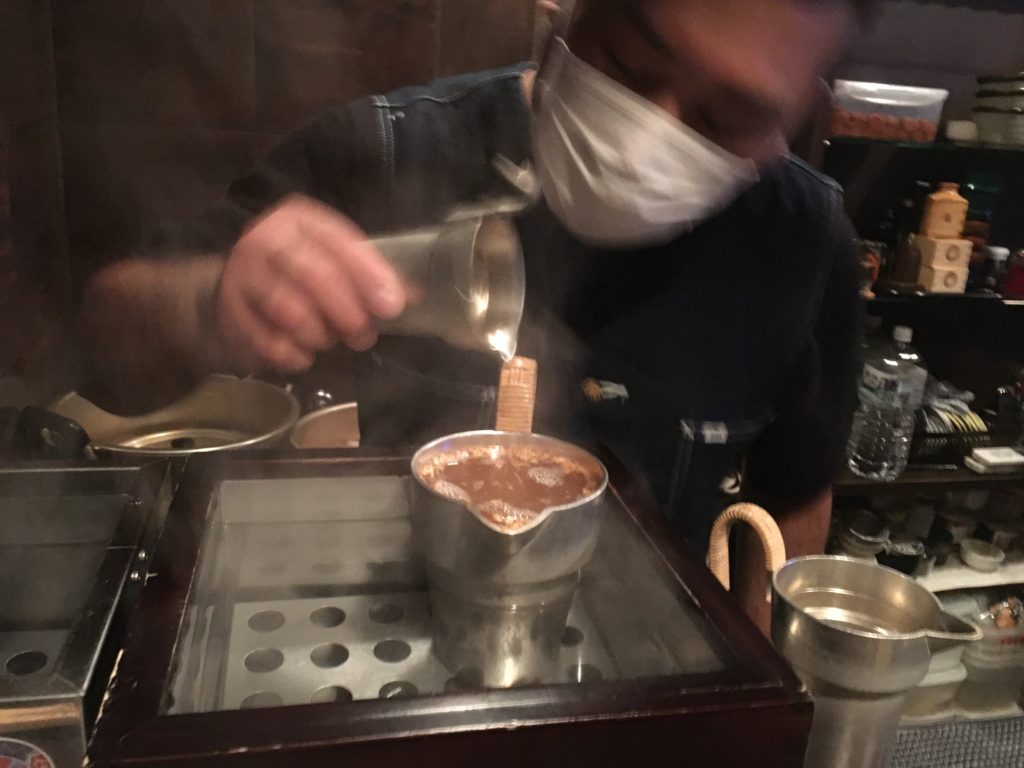
For the next sake, Masa puts powder into hot sake. Oh my god, it’s really cooking!
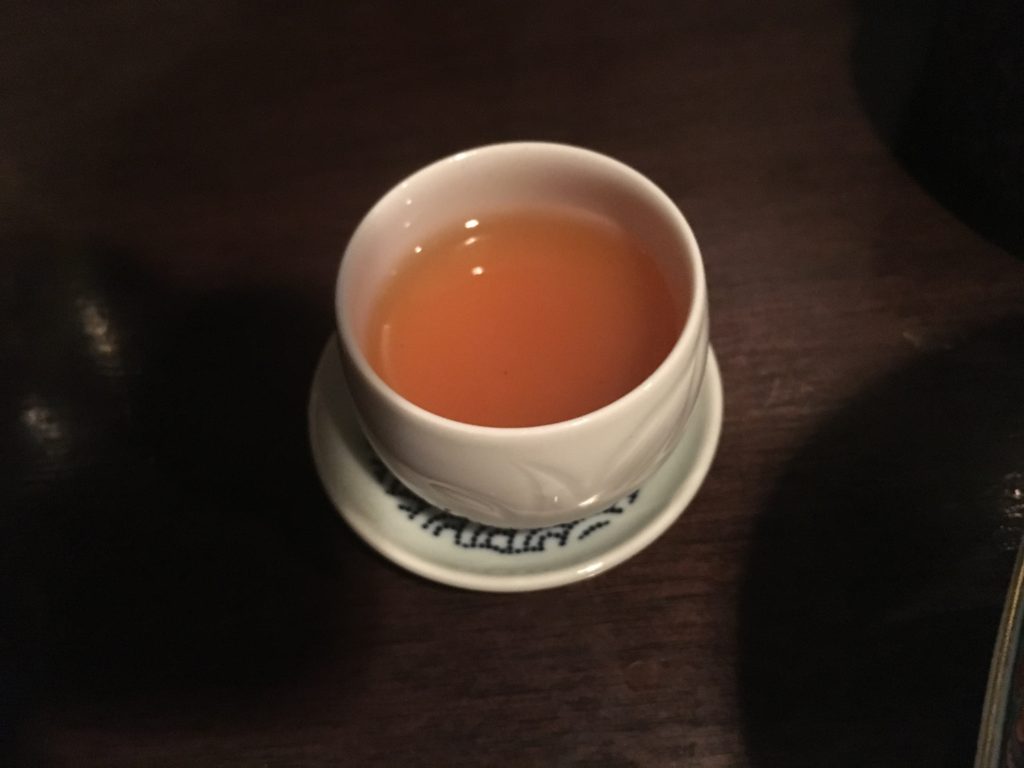
He heats up Niida Shizen-shu Genshu (undiluted sake) with dashi powder, and pairs this with nimono, saying, ”I count this combination as one dish.”
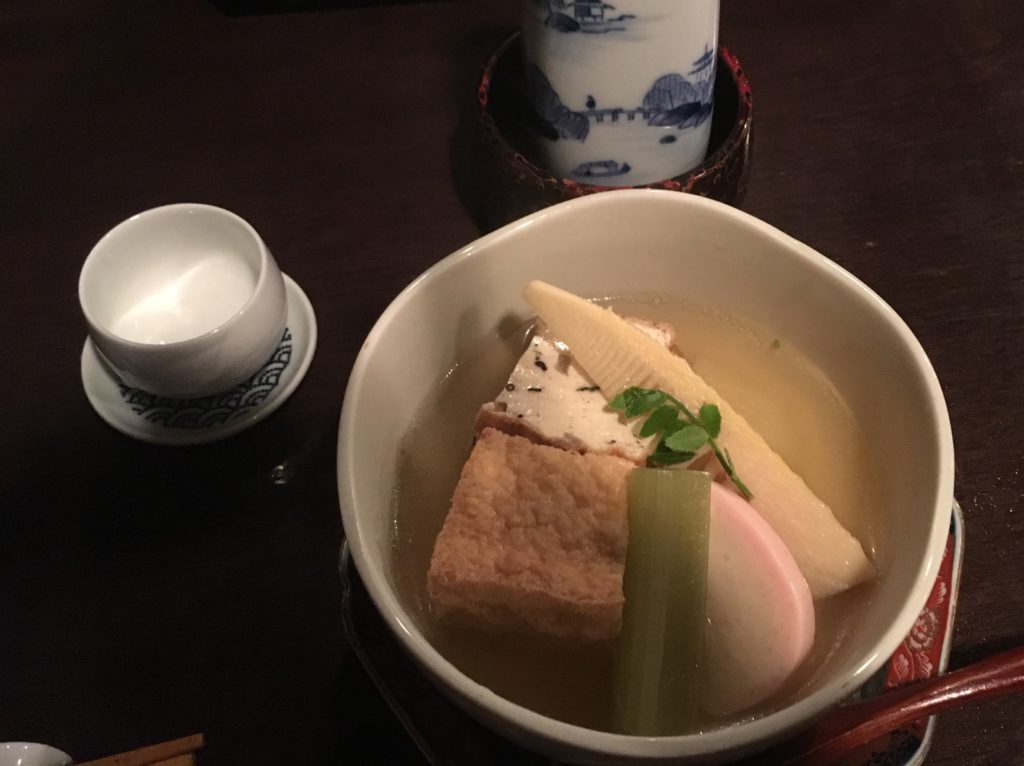
Ah, I feel like soaking myself into this combination…The flavor not only runs into my throat but also spreads fully throughout my mouth.
Nimono tastes calm, while hot sake tastes richer. This difference creates the perfect balance.
I can keep drinking it forever.
(My writing goes crazy from here – I am in a state of hot-sake trance.)
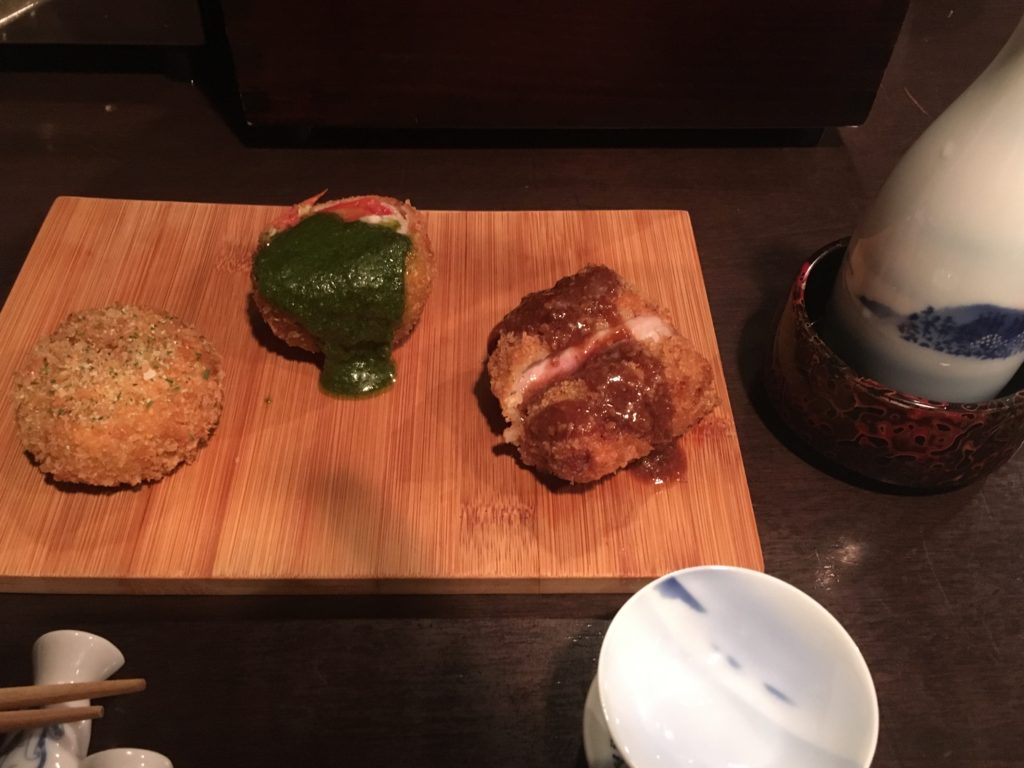
The next sake is Maibijin by Mikawa Shuzojo (Fukui). Abundantly acidic, it’s paired with three pieces of deep-fried food.
Masa warms this sake with a copper vessel, swaps it out into a tin vessel, then adds cool sake into it…etc, etc. Finally, he puts elderflower in it!
It tastes totally the same as hot lemonade! It’s sour, but not stinging. This sake cleanses the grease in your mouth. It’s especially best with the deep-fried tomato in the center of the picture above.
“When sake fans visit breweries, they are content with just ‘seeing’ it. I am different. I visit breweries to consider ‘how to cook’ their sake, just as a chef does when visiting farmers to consider their products,” Masa said.
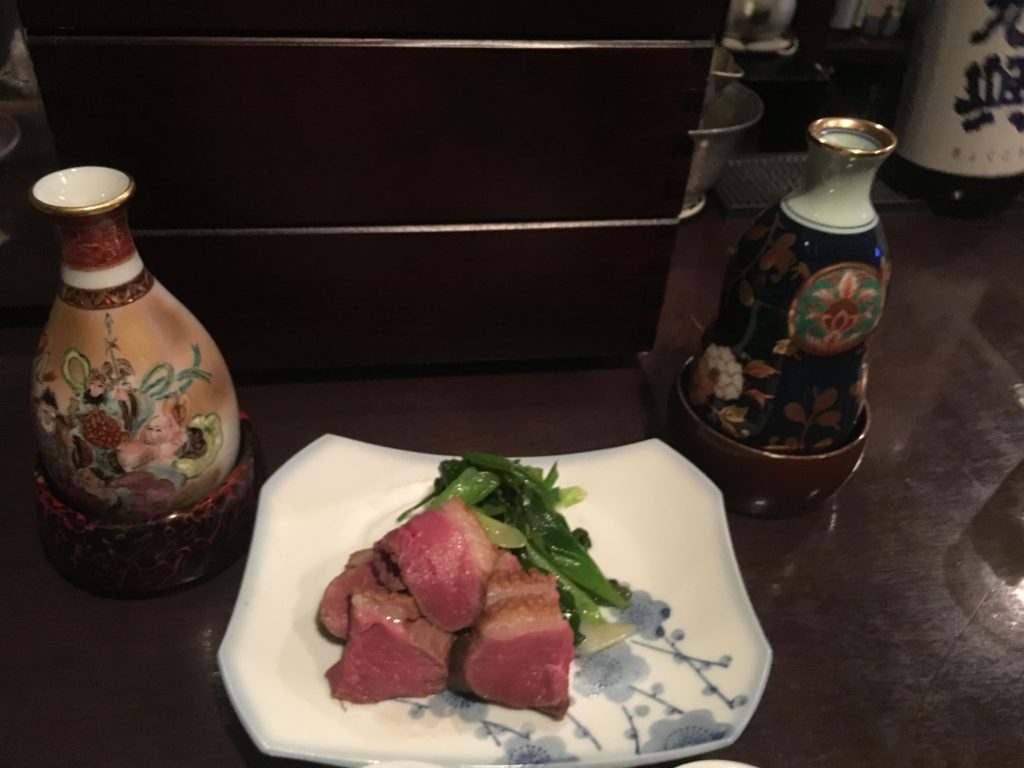
Masa serves two kinds of hot sake with rare-cooked duck. One is clean and elegant, another is gentle and round. Even though each characteristic is different, both taste perfect with duck.
This experience showed me that there’s more than one answer for a pairing.
Lastly, what I was mostly shocked about was what I introduced at the beginning of this article: the blend of hot nigori sake, coconut milk, and another sake.
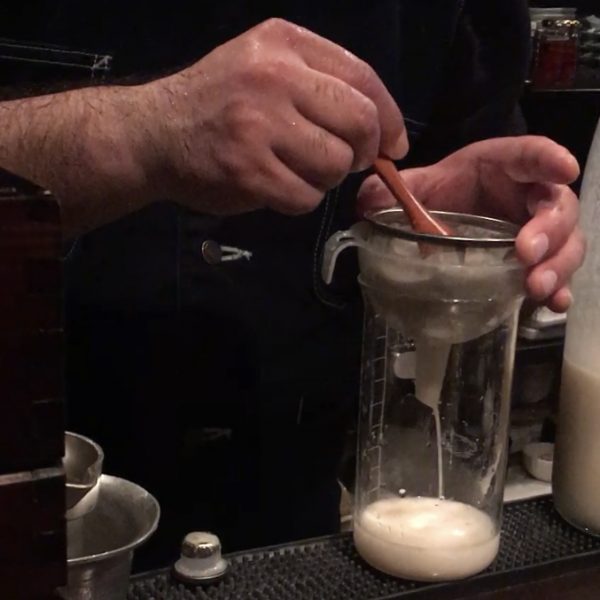
What on earth is this hot sake? I was totally confused.
I’ve heard that we can enjoy sake freely, but I never imagined that I could see such amazing sake feats. But everything is just too tasty to understand what’s going on.
I realized I had already drunk 6 go (1080mL/37oz) while being overwhelmed by Masa’s hot sake techniques. It’s too much, but curiously, I didn’t get a hangover after following Masa’s advice: “Don’t drink beer after getting home,” he said.
What the hell did I just experience at Gats?
It’s super rare for even Japanese. You can have a liberating, mysterious, and an extraordinarily delicious experience here.
Please try Gats if you like hot sake. Your impression of hot sake could change completely.